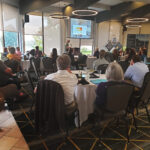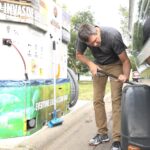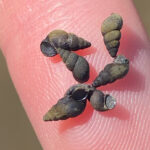Together again! WALPA reconvenes in person for annual conference
In late October, WALPA met in Wenatchee for our first in-person conference since 2019! It was truly amazing to see old friends again, and equally great to meet some in person for the first time.
Activities commenced on Wednesday, October 19, with an invasive plant species workshop presented by Ben Peterson (King County) and Brian Turner (WDFW). With actual specimens on display, the workshop provided a great learning experience. Anyone working on removal of invasives was able to see a variety of these plants “up close and in person.”
County-wide prevention infrastructure encourages boat owners to help control the spread of invasives
WATERLINE SPONSORED CONTENT
Hennepin County, in Minnesota’s Twin Cities metro area, is home to more than 60 public boat ramps in areas rural to urban. These public accesses are owned by a variety of state and local agencies, which brings challenges in creating consistent standards to prevent the spread of aquatic invasives.
The county is a Minnesota leader in developing behavioral cues like signage, pavement markers, arrows, and cleanout zones to encourage best management practices at public boat ramps/accesses. But after observing boater behaviors when no inspectors are on site, agency staff realized that these cues alone are insufficient to ensure public compliance 24/7.
Quantifying the impacts of New Zealand mudsnail on the ecology of Spirit Lake, Mount St. Helens National Volcanic Monument
By Hailey Germeau, University of Washington, Tacoma
The New Zealand mudsnail (NZMS), introduced to the U.S. in the 1980s, is a priority invasive species in Washington State. It was first detected in 2015 in Spirit Lake, north of Mount St. Helens, where its population is quickly increasing. Studies of this highly invasive species reveal no ecological benefit to Spirit Lake, causing a trophic cascade due to its lack of natural predators, voracious herbivory, and interspecies competition with native snail species. To track the spread of NZMS and its ecological impacts on Spirit Lake, temporal sampling of vegetation and sediment was carried out throughout the lake from July-September 2022. Snail counts were used to calculate snail population densities, spatial and temporal variability, substrate preference, presence in sediments, and interspecies competition.
Impact of dry deposition on nutrient inputs to Spirit Lake, Mount St. Helens National Volcanic Monument
By Heaven Denham, University of Washington Tacoma, Environmental Sciences
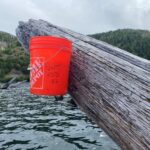 Previous research in 2018 by James E. Gawel, Charles M. Crisafulli, and Rich Miller measured a complete nutrient budget for Spirit Lake but found an imbalance in inputs versus outputs of nitrogen and phosphorus, with outputs being greater than inputs. The only factors that were not measured were the dry and wet deposition inputs; instead, regional estimated data was used to calculate the deposition input of total N and P over five months. We wanted to find out if there was a significant input of total N and P from dry deposition to explain the imbalance.
Previous research in 2018 by James E. Gawel, Charles M. Crisafulli, and Rich Miller measured a complete nutrient budget for Spirit Lake but found an imbalance in inputs versus outputs of nitrogen and phosphorus, with outputs being greater than inputs. The only factors that were not measured were the dry and wet deposition inputs; instead, regional estimated data was used to calculate the deposition input of total N and P over five months. We wanted to find out if there was a significant input of total N and P from dry deposition to explain the imbalance.
Revisiting the Lake Washington sediment record: what sediment coring studies can tell us about long-term water quality trends
By Curtis DeGasperi, King County Water and Land Resources Division and Will Hobbs, Washington State Department of Ecology
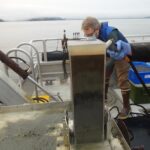 We monitor water quality over time to identify trends and relate them to changes due to human activity. However, water quality monitoring data often don’t go back far enough in time because monitoring doesn’t typically begin before potential human impacts are identified. Furthermore, trends caused by natural variability in these relatively short records can be mistaken for human-caused trends. Lake sediments provide a layered history that integrates the changes in inputs from the water and airsheds that can be consulted at any time using a consistent set of methods [For example, see this June 2022 WATERLINE article]. We conducted a sediment coring pilot study in Lake Washington to assess the potential utility of this approach in evaluating water quality trends and detecting human-caused changes.
We monitor water quality over time to identify trends and relate them to changes due to human activity. However, water quality monitoring data often don’t go back far enough in time because monitoring doesn’t typically begin before potential human impacts are identified. Furthermore, trends caused by natural variability in these relatively short records can be mistaken for human-caused trends. Lake sediments provide a layered history that integrates the changes in inputs from the water and airsheds that can be consulted at any time using a consistent set of methods [For example, see this June 2022 WATERLINE article]. We conducted a sediment coring pilot study in Lake Washington to assess the potential utility of this approach in evaluating water quality trends and detecting human-caused changes.

